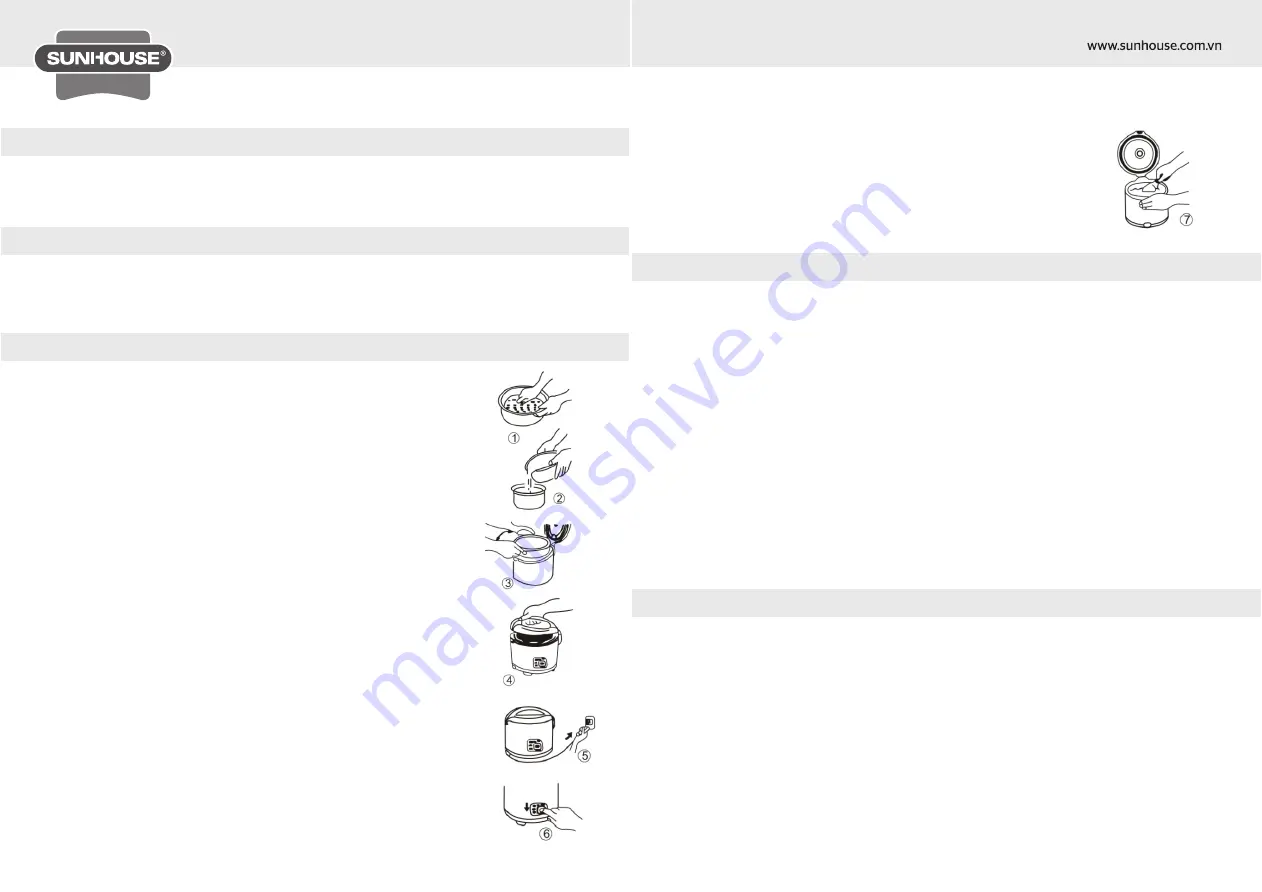
1. Refrain from using a multi-purpose adaptor.
2. Do not operate the rice cooker when empty or when maximum capacity Is
exceeded.
3. Keep away from direct sources of heat or strong sunlight to prevent possible
damage.
4. Do not cover or obstruct the steam vent, Where possible, keep the rice cooker
away from overhead cabinets or equipment.
5. Replace rubber gasket on the lid when it is showing signs of fatigue or wear.
(Please contact your local distributor for replacement details.)
6. Always keep the rice cooker unplugged when not in use.
7. Do not Immerse the rice cooker or supply cord In water or any liquid or allow any
liquid to come into contact with electrical parts.
Remove all packaging materials. Wash the non-stick cooking pan in hot, soapy
water using a sponge or dishcloth. Rinse thoroughly. Wipe the lid and make sure
the exterior of the cooking pan Is dry.
The electric cord needs to be pulled to Its full extension prior to use. Stop pulling
when a coloured band comes Into view. To cord will automatically retract Into the
appliance.
1.Measure out required quantity of rice using measuring cup
provided. Wash rice in a sieve until the water is clear, then put
rice In the cooking pan and add water up to the level which
corresponds to the measure of rice used. E.g. For 4 cups of rice,
add water to level 4 as marked on the inside of the cooking pan.
However, the quantity of water used will depend on the age
and strain of the rice, as well as personal taste.
Do not exceed the maximum water level mark.
2.Set the cooking pan Inside the rice cooker, making certain
that the base Is dry. Ensure that cooking pan is in direct contact
with the heating element by rotating It slightly left and right
until it seats properly. The rice cooker may maltifunction if the
cooking pan is incorrectly positioned.
Always keep the exterior bottom of the cooking pan ® and
heating plate clean and dry.
3. When ready to cook, connect the power supply cord to the
rice cooker first, then plug into an AC wall outlet.
Press COOK. Once rice is cooked, a built-in heat sensor will
automatically switch to WARM mode. Allow rice to rest for
about 15 minutes before serving.
4. Using the rice paddle, huff up the rice to keep the grains
separate.
Do not use metal utensils on the non - stick lined cooking pan.
V. BEFORE USING THE FIRST TIME
VI. ELECTRIC CORD
VIII. TO CLEAN
IX. HELPFUL WARNINGS
10
11
Remember to unplug the rice cooker when not in use.
5. When rice is cooked, it can be kept warm for a long time. The
cooker won't be damaged after keeping warm for 24 hours
long.The power is 48W when keeping warm.
Always unplug the rice cooker and allow to cool before cleaning.
1 .Wash the cooking pan In warm, soapy water using a sponge or
VII. USE
dishcloth. Do not use harsh abrasive cleaners pre or products which are not
considered safe to use on :non-stick coatings. Rinse and dry thoroughly.
Keep the cooking pan scrupulously clean especially If salt or salty ingredients have
been used. Salt is very corrosive and will damage the non - stick lining.
The non-stick coating will dlscolur after a period of use. This Is normal and will not
affect your health or the use of the rice cooker.
2.Detach the inner lid form the shaft by gently tugging it outwards. Soak briefly and
wash clean.
3.Gently remove the dew collector (fitted onto the back of the rice cooker) by
pulling downwards. Discard the water after every use.
4.Wipe over other surfaces with a damp cloth,paying attention to recesses which
could trap food or water. Do not immerse the rice cooker in water or any liquid.
5.Check to make sure the heating plate Is clean and free of food or grit which could
interfere with the proper functioning of the rice cooker. Any burnt-on residue could
be removed by gently scrubbing the heating plate with a damp piece of steel wool.
Then wipe and dry the heating plate to ensure good contact with the cooking pan.






